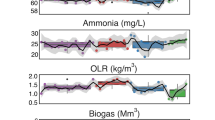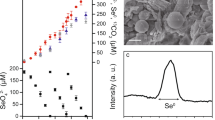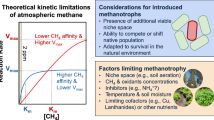Abstract
Biodiversity is claimed to be essential for ecosystem functioning, but is threatened by anthropogenic disturbances. Prokaryotes have been assumed to be functionally redundant and virtually inextinguishable. However, recent work indicates that microbes may well be sensitive to environmental disturbance. Focusing on methane-oxidizing bacteria as model organisms, we simulated disturbance-induced mortality by mixing native with sterilized paddy soil in two ratios, 1:4 and 1:40, representing moderate and severe die-offs. Disturbed microcosms were compared with an untreated control. Recovery of activity and populations was followed over 4 months by methane uptake measurements, pmoA-qPCR, pmoA-based terminal restriction fragment length polymorphism and a pmoA-based diagnostic microarray. Diversity and evenness of methanotrophs decreased in disturbed microcosms, but functioning was not compromised. We consistently observed distinctive temporal shifts between type I and type II methanotrophs, and a rapid population growth leading to even higher cell numbers comparing disturbed microcosms with the control. Overcompensating mortality suggested that population size in the control was limited by competition with other bacteria. Overall, methanotrophs showed a remarkable ability to compensate for die-offs.
Similar content being viewed by others
Log in or create a free account to read this content
Gain free access to this article, as well as selected content from this journal and more on nature.com
or
References
Allison SD, Martiny JBH . (2008). Resistance, resilience, and redundancy in microbial communities. Proc Natl Acad Sci USA 105: 11512–11519.
Baani M, Liesack W . (2008). Two isozymes of particulate methane monooxygenase with different methane oxidation kinetics are found in Methylocystis sp strain SC2. Proc Natl Acad Sci USA 105: 10203–10208.
Bak F, Scheff G, Jansen KH . (1991). A rapid and sensitive ion chromatographic technique for the determination of sulfate and sulfate reduction rates in freshwater lake sediments. FEMS Microbiol Ecol 85: 23–30.
Bodelier PLE, Hahn AP, Arth I, Frenzel P . (2000a). Effects of ammonium-based fertilisation on microbial processes involved in methane emission from soils planted with rice. Biogeochemistry 51: 225–257.
Bodelier PLE, Laanbroek HJ . (2004). Nitrogen as a regulatory factor of methane oxidation in soils and sediments. FEMS Microbiol Ecol 47: 265–277.
Bodelier PLE, Roslev P, Henckel T, Frenzel P . (2000b). Stimulation by ammonium-based fertilizers of methane oxidation in soil around rice roots. Nature 403: 421–424.
Bodrossy L, Stralis-Pavese N, Murrell JC, Radajewski S, Weilharter A, Sessitsch A . (2003). Development and validation of a diagnostic microbial microarray for methanotrophs. Environ Microbiol 5: 566–582.
Bosse U, Frenzel P, Conrad R . (1993). Inhibition of methane oxidation by ammonium in the surface layer of a littoral sediment. FEMS Microbiol Ecol 13: 123–134.
Conrad R . (2009). The global methane cycle: recent advances in understanding the microbial processes involved. Environ Microbiol Rep 1: 285–292.
Dedysh SN, Liesack W, Khmelenina VN, Suzina NE, Trotsenko YA, Semrau JD et al. (2000). Methylocella palustris gen. nov., sp. nov., a new methane-oxidizing acidophilic bacterium from peat bogs, representing a novel subtype of serine-pathway methanotrophs. Int J Syst Evol Microbiol 50: 955–969.
Dunbar J, Ticknor LO, Kuske CR . (2001). Phylogenetic specificity and reproducibility and new method for analysis of terminal restriction fragment profiles of 16S rRNA genes from bacterial communities. Appl Environ Microbiol 67: 190–197.
Dunfield PF, Yimga TM, Dedysh SN, Berger U, Liesack W, Heyer J . (2002). Isolation of a Methylocystis strain containing a novel pmoA-like gene. FEMS Microbiol Ecol 41: 17–26.
Eller G, Krüger M, Frenzel P . (2005). Comparing field and microcosm experiments: a case study on methano- and methylotrophic bacteria in paddy soil. FEMS Microbiol Ecol 51: 279–291.
Holmes AJ, Owens NJP, Murrell JC . (1995). Detection of novel marine methanotrophs using phylogenetic and functional gene probes after methane enrichment. Microbiology (UK) 141: 1947–1955.
Horz HP, Rich V, Avrahami S, Bohannan BJM . (2005). Methane-oxidizing bacteria in a California upland grassland soil: diversity and response to simulated global change. Appl Environ Microbiol 71: 2642–2652.
Intergovernmental Panel on Climate Change (2007). Climate Change 2007: The Physical Science Basis. Summary for Policymakers. Contribution of Working Group I to the Fourth Assessment Report of the Intergovernmental Panel on Climate Change. Summary for Policymakers Formally Approved at the 10th Session of Working Group I of the IPCC. IPCC Secretariat: Geneva.
Ives AR, Carpenter SR . (2007). Stability and diversity of ecosystems. Science 317: 58–62.
Klappenbach JA, Dunbar JM, Schmidt TM . (2000). rRNA operon copy number reflects ecological strategies of bacteria. Appl Environ Microbiol 66: 1328–1333.
Kolb S, Knief C, Stubner S, Conrad R . (2003). Quantitative detection of methanotrophs in soil by novel pmoA-targeted real-time PCR assays. Appl Environ Microbiol 69: 2423–2429.
Kreader CA . (1996). Relief of amplification inhibition in PCR with bovine serum albumin or T4 gene 32 protein. Appl Environ Microbiol 62: 1102–1106.
Krüger M, Frenzel P, Conrad R . (2001). Microbial processes influencing methane emission from rice fields. Global Change Biol 7: 49–63.
Le Roux X, Philippot L, Degrange V, Poly F, Wertz S . (2006). Biodiversity-functioning relations in microorganisms. Biofutur 268: 50–53.
Loreau M, Naeem S, Inchausti P, Bengtsson J, Grime JP, Hector A et al. (2001). Biodiversity and ecosystem functioning: current knowledge and future challenges. Science 294: 804–808.
Lüke C, Krause S, Cavigioli S, Greppi D, Lupotto E, Frenzel P . (2010). Biogeography of wetland rice methanotrophs. Environ Microbiol 12: 862–872.
Mccann KS . (2000). The diversity-stability debate. Nature 405: 228–233.
McDonald IR, Bodrossy L, Chen Y, Murrell JC . (2008). Molecular ecology techniques for the study of aerobic methanotrophs. Appl Environ Microbiol 74: 1305–1315.
McNamara NP, Black HIJ, Beresford NA, Parekh NR . (2003). Effects of acute gamma irradiation on chemical, physical and biological properties of soils. Appl Soil Ecol 24: 117–132.
McNamara NP, Griffiths RI, Tabouret A, Beresford NA, Bailey MJ, Whiteley AS . (2007). The sensitivity of a forest soil microbial community to acute gamma-irradiation. Appl Soil Ecol 37: 1–9.
Murase J, Frenzel P . (2007). A methane-driven microbial food web in a wetland rice soil. Environ Microbiol 9: 3025–3034.
Murase J, Noll M, Frenzel P . (2006). The impact of protists on activity and structure of the bacterial community in a rice field soil. Appl Environ Microbiol 72: 5436–5444.
Murase J, Frenzel P . (2008). Selective grazing of methanotrophs by protozoa in a rice field soil. FEMS Microbiol Ecol 65: 408–414.
Oksanen J, Blanchet FG, Kindt R, Legendre P, O'Hara RG, Simpson GL et al. (2010). Vegan: Community ecology package. 1.18-12. http://R-Forge.R-project.org/projects/vegan/.
Pielou EC . (1977). Mathematical Ecology. John Wiley & Sons: New York.
Pietramellara G, Ascher J, Borgogni F, Ceccherini MT, Guerri G, Nannipieri P . (2009). Extracellular DNA in soil and sediment: fate and ecological relevance. Biol Fertil Soils 45: 219–235.
Priemé A, Christensen S, Dobbie KE, Smith KA . (1997). Slow increase in rate of methane oxidation in soils with time following land use change from arable agriculture to woodland. Atmos Environ 29: 1269–1273.
R Development Core Team (2009). R: A Language and Environment for Statistical Computing 2.10.1. R Foundation for Statistical Computing. ISBN 3-900051-07-0.http://www.R-project.org.
Reeburgh WS, Whalen SC, Alperin MJ . (1993). The role of methylotrophy in the global methane budget. In: Murrell JC, Kelly DP (eds). Microbial Growth on C-1 Compounds. Intercept: Andover, pp 1–14.
Revsbech NP . (1989). An oxygen microsensor with a guard cathode. Limnol Oceanogr 34: 474–478.
Semrau JD, Chistoserdov A, Lebron J, Costello A, Davagnino J, Kenna E et al. (1995). Particulate methane monooxygenase genes in methanotrophs. J Bacteriol 177: 3071–3079.
Shrestha PM, Noll M, Liesack W . (2007). Phylogenetic identity, growth-response time and rRNA operon copy number of soil bacteria indicate different stages of community succession. Environ Microbiol 9: 2464–2474.
Spain AM, Krumholz LR, Elshahed MS . (2009). Abundance, composition, diversity and novelty of soil Proteobacteria. ISME J 3: 992–1000.
Stralis-Pavese N, Sessitsch A, Weilharter A, Reichenauer T, Riesing J, Csontos J et al. (2004). Optimization of diagnostic microarray for application in analysing landfill methanotroph communities under different plant covers. Environ Microbiol 6: 347–363.
Stubner S . (2002). Enumeration of 16S rDNA of Desulfotomaculum lineage 1 in rice field soil by real-time PCR with SybrGreenTM detection. J Microbiol Methods 50: 155–164.
Torsvik V, Øvreås L, Thingstad TF . (2002). Prokaryotic diversity—magnitude, dynamics, and controlling factors. Science 296: 1064–1066.
Trotsenko YA, Murrell JC . (2008). Metabolic aspects of aerobic obligate methanotrophy. Adv Appl Microbiol 63: 183–229.
Wertz S, Degrange V, Prosser JI, Poly F, Commeaux C, Guillaumaud N et al. (2007). Decline of soil microbial diversity does not influence the resistance and resilience of key soil microbial functional groups following a model disturbance. Environ Microbiol 9: 2211–2219.
Wickham H . (2009). Ggplot2. Elegant Graphics for Data Analysis. Springer: Dordrecht.
Wittebolle L, Marzorati M, Clement L, Balloi A, Daffonchio D, Heylen K et al. (2009). Initial community evenness favours functionality under selective stress. Nature 458: 623–626.
Yimga TM, Dunfield PF, Ricke P, Heyer J, Liesack W . (2003). Wide distribution of a novel pmoA-like gene copy among type II methanotrophs, and its expression in Methylocystis strain SC2. Appl Environ Microbiol 69: 5593–5602.
Acknowledgements
We thank Leventhe Bodrossy (Seibersdorf/Austria) for introducing us to the pmoA microarray and for discussion on microarray analysis. Alexandra Hahn and Bellinda Schneider provided excellent technical assistance. This study was financially supported by the International Max Planck Research School for Environmental, Cellular and Molecular Microbiology by a grant to AH, and by the Deutsche Forschungsgemeinschaft by a grant to PF. This is a contribution of METHECO to the ESF-coordinated EUROCORES-program EuroDIVERSITY.
Author information
Authors and Affiliations
Corresponding author
Additional information
Supplementary Information accompanies the paper on The ISME Journal website
Rights and permissions
About this article
Cite this article
Ho, A., Lüke, C. & Frenzel, P. Recovery of methanotrophs from disturbance: population dynamics, evenness and functioning. ISME J 5, 750–758 (2011). https://doi.org/10.1038/ismej.2010.163
Received:
Revised:
Accepted:
Published:
Issue date:
DOI: https://doi.org/10.1038/ismej.2010.163
Keywords
This article is cited by
-
Type I methanotrophs dominated methane oxidation and assimilation in rice paddy fields by the consequence of niche differentiation
Biology and Fertility of Soils (2024)
-
Interkingdom interaction: the soil isopod Porcellio scaber stimulates the methane-driven bacterial and fungal interaction
ISME Communications (2023)
-
The methane-driven interaction network in terrestrial methane hotspots
Environmental Microbiome (2022)
-
Disproportionate increase in freshwater methane emissions induced by experimental warming
Nature Climate Change (2020)
-
Deforestation for oil palm: impact on microbially mediated methane and nitrous oxide emissions, and soil bacterial communities
Biology and Fertility of Soils (2020)



